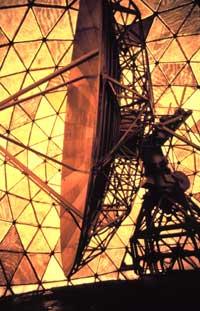Emergency ozone layer
2000/08/31 Roa Zubia, Guillermo - Elhuyar Zientzia
Recent data from Antarctica indicate that the situation is worrying
The ozone layer continues to decline. Reports published in August by the international meteorologist organization, WMO, have provided troubling data. 30% of the ozone it should contain has been lost. The reports explain how the natural conditions of Antarctica aggravate the problem. However, in addition to Antarctica, the adjacent territories have been analyzed. It is not easy to explain everything, but the situation is evident. While emissions of ozone-destroying molecules have been controlled, ozone layer reduction has not remained.
Agreements have been signed in recent years and measures have been taken to protect the stratosphere. Although it has not been entirely, CFC spill (famous ozone destroying molecules) has been controlled. However, the decrease in the ozone layer has not ceased. According to the latest reports, only 30% of the concentration between 1964 and 76 is currently maintained. Scientists are very concerned about this outcome.
Observations and measurements are made by the World Meteorological Organization (WMO). It has special stations and satellites located on Earth. It seems that we are in a very suitable time to reflect on the situation.
This month WMO has published two reports in which the latest data collected is collected. Reports are available at www.wmo.ch. The first was published on the 11th and offered troubling data. The second, of 25, was drafted to update the previous one. The situation is even more serious.
Blind satellites
Satellites to measure ozone concentration need light. Since the preparation of the first report, the sunlit area has been expanded and more data has been collected. In addition, data have been collected from four Antarctic stations, the French Dumont d'Urville, the Russian Mirni, the Japanese Syowa and the Ukrainian Vernadski. Its results show that for 30 years the reduction ranges from 20 to 35%. The global data provided by WMO is 30%.
Data from other facilities near Antarctica have also been collected, and while the reduction is not so important, it can be considered representative of the situation. For example, the Ushuaia observatory in Patagonia has measured a 20% reduction. These observatories revolve around the Antarctica that receives sunlight.
The hope of some scientists is related to the sun. Your radiation activity has a cycle of 11 years. This year is the peak of this cycle. The radiation the Earth is receiving may be responsible for the speed of ozone destruction. Maybe not. It will look in a few years.
The lowest temperatures of the year have already been. From now on, scientists expect the southern spring. Fortunately, the stratosphere will gradually heat up and these clouds will melt. These conditions occur every winter in Antarctica. It is a natural process. Think about who produces chlorine molecules. A good time for deep reflection.

Gai honi buruzko eduki gehiago
Elhuyarrek garatutako teknologia





